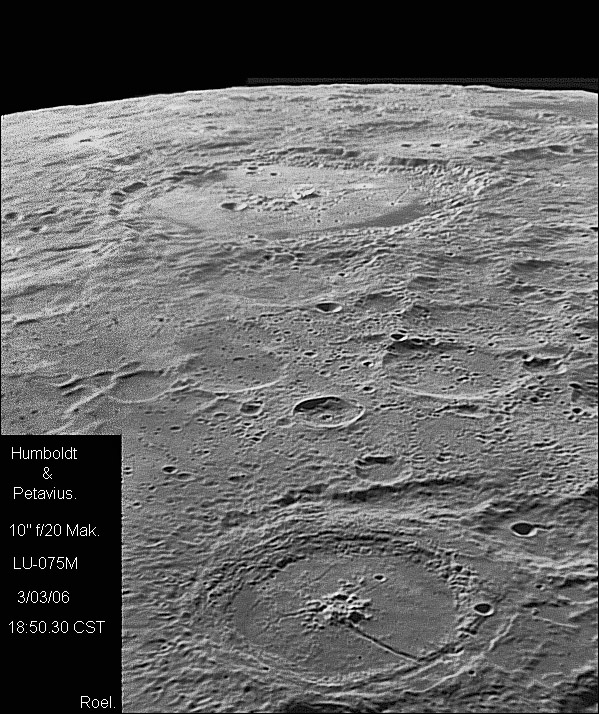|
|
| (4 intermediate revisions by the same user not shown) |
| Line 1: |
Line 1: |
| | __NOTOC__ | | __NOTOC__ |
| − | =On the Limb Again, Ii= | + | =On the Limb Again, II= |
| | + | <!-- Start of content --> |
| | <div class="post" id="post-587"> | | <div class="post" id="post-587"> |
| | | | |
| Line 7: |
Line 8: |
| | <em>image by [mailto:eroel@prodigy.net.mx Eric Roel]</em></p> | | <em>image by [mailto:eroel@prodigy.net.mx Eric Roel]</em></p> |
| | <p><em>I am busy writing final reports to NASA - on benchmarking educational technologies and learning and videogames - and must replay another LPOD hit - this classic is from March 7, 2006. Re-enjoy! </em></p> | | <p><em>I am busy writing final reports to NASA - on benchmarking educational technologies and learning and videogames - and must replay another LPOD hit - this classic is from March 7, 2006. Re-enjoy! </em></p> |
| − | <p>Being only 5 degrees this side of the nominal east limb, the 160 km wide crater Humboldt is rarely seen as well as in this wonderful mosaic by Eric Roel. As we saw in an earlier [http://www.lpod.org/?m=20060206 <i>LPOD</i>], Humboldt is a magnificent floor-fractured crater with rilles and dark halo deposits erupted from small volcanic vents. Just behind Humboldt is Barnard – you can recognize it from the two small craters near its center. In the foreground is another, better known floor-fractured crater, Petavius, with its rilles – big and small – and dark deposits. Petavius is a minor version of Humboldt. As I have said before, I wish the Moon weren’t locked in synchronous rotation with the Earth – then we could see all its sides, including the fascinating Humboldt, face on!</p> | + | <p>Being only 5 degrees this side of the nominal east limb, the 160 km wide crater Humboldt is rarely seen as well as in this wonderful mosaic by Eric Roel. As we saw in an earlier [[February_6,_2006| <i>LPOD</i>]], Humboldt is a magnificent floor-fractured crater with rilles and dark halo deposits erupted from small volcanic vents. Just behind Humboldt is Barnard – you can recognize it from the two small craters near its center. In the foreground is another, better known floor-fractured crater, Petavius, with its rilles – big and small – and dark deposits. Petavius is a minor version of Humboldt. As I have said before, I wish the Moon weren’t locked in synchronous rotation with the Earth – then we could see all its sides, including the fascinating Humboldt, face on!</p> |
| | <p>[mailto:tychocrater@yahoo.com Chuck Wood]</p> | | <p>[mailto:tychocrater@yahoo.com Chuck Wood]</p> |
| | <p><strong>Technical Details:</strong><br /> | | <p><strong>Technical Details:</strong><br /> |
| Line 15: |
Line 16: |
| | <p><b>Yesterday's LPOD:</b> [[September 28, 2006|Smart-1 Crater not Observed]] </p> | | <p><b>Yesterday's LPOD:</b> [[September 28, 2006|Smart-1 Crater not Observed]] </p> |
| | <p><b>Tomorrow's LPOD:</b> [[September 30, 2006|Fascinating Fototrickery]] </p> | | <p><b>Tomorrow's LPOD:</b> [[September 30, 2006|Fascinating Fototrickery]] </p> |
| − | <p align="center"><b>SUPPORT LPOD - VISIT A SPONSOR (CLICK AN AD BELOW)!</b></p> | + | <!-- Remove click bait --> |
| − | <p><b>Yesterday's LPOD:</b> [[September 28, 2006|Smart-1 Crater not Observed]] </p>
| |
| − | <p><b>Tomorrow's LPOD:</b> [[September 30, 2006|Fascinating Fototrickery]] </p>
| |
| | </div> | | </div> |
| − | ----
| + | <!-- End of content --> |
| − | ===COMMENTS?===
| + | {{wiki/ArticleFooter}} |
| − | Register, and click on the <b>Discussion</b> tab at the top of the page.
| |
| − | <hr>
| |
| − | <!-- | |
| − | You can support LPOD when you buy any book from Amazon thru [[Support_ LPOD|LPOD]]!
| |
| − | -->
| |
| − | <span style="font-size:88%">
| |
| − | <center>
| |
| − | Contributions to http://www2.lpod.org/ are licensed under a Creative Commons Attribution No-Derivative-Works Non-Commercial 3.0 License. [http://www.creativecommons.org/licenses/by-nc-nd/3.0 http://www.wikispaces.com/i/creativecommons/by-nc-nd_3.0_80x15.png]<br>
| |
| − | </center>
| |
| − | </span>
| |




